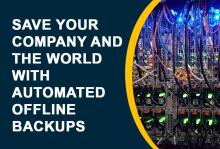
The specter of ransomware lockers haunts every organization — and the fear is justified.
Ransomware is worse than malware: systems and data are all locked up, and backups are all encrypted, too. Everything connected to the physical machines or connected to the Internet gets locked down.
Your organization stops operating. Nothing can move forward. Ransoms must be paid, and trust in your organization and systems is lost forever.

A CyberCrime Explosion is Coming
In May 2021 testimony before the House Committee on Homeland Security, Christopher Krebs, the former head of the Department of Homeland Security’s Cybersecurity and Infrastructure Security Agency, warned about a “cybercrime explosion” threatening national security
Two days later, hackers hit the Colonial Pipeline. The company’s VPN was accessed through a single compromised password.
After a $4.4 million ransom, an intensive investigation had to be performed to ensure the hackers hadn’t gained access to the software that operated the pipeline’s infrastructure. The pipeline was shut down to prevent tampering, and gas shortages caused panic across the country.
While your organization may not control the power or fuel pipelines for the nation, the stakes are just as high for your customers and employees.
Hospitals, food suppliers, transportation, emergency systems, and even your organization play important roles in our society. If your systems are attacked, lives are literally at stake.
Offline backups will save your company -- and the world
Of course, there’s an easy security solution to the coming CyberCrime Explosion: offline backups.
Offline backups back up the organization’s data to a drive that’s not connected to the internet and therefore can’t be hacked. This is important even for teams that do cloud backups, which are also vulnerable to the same kind of hacking (not to mention data theft).
The catch?
Most MSPs and IT teams will say they do rotating offline backups. Most of them really do, at least for a while! But offline backups take time and discipline. And in the day-to-day grind of business - they are often forgotten or not done as frequently as they need to be.
And on the day, week, or month it gets forgotten, the ransomware hits.
In fact, hackers know that the ‘forgotten backup’ happens, and they count on it, waiting for the day the backup doesn’t happen.
That turns a simple forgotten task into a huge, expensive problem.
The solution: Automating offline backups with USB technology
The answer to any repetitive task that needs to be done on a regular schedule is automation.
Ideally, offline backups would be as easy as cloud backups, which run regularly without any action from the user. (Speaking of which, automated cloud backups are actually another reason to have offline backups: regularly run cloud backups can write over the original files with the corrupted versions after the attack occurs).
The offline part of offline backups makes it tricky, though. Any automation is likely to be on the computer and connected to the internet, making it vulnerable.
That’s the problem we’re addressing via our USBHub3+ hub, which allows the user to customize and automate which USB ports get turned on and off.
This means the port itself opens and closes, making the backup device immune to hacking when it’s closed, and only connected for as long as the backup takes.
You can program the hub on a customized schedule to ensure backups are done regularly, at the right pace. Not only is this method more secure, but it also frees up tech talent from repetitive tasks.
The end goal: reducing ransomware exposure
USB technology like this makes the job a bit easier for MSP and IT teams, taking a manual task and turning it automatic. But of course, the real goal is security.
Automated, regular offline backups that occur as quickly as possible through a port that’s automatically shut off is a secure way to keep data safe from ransomware and malware attacks.
Rather than engaging with hackers or spending countless hours sorting through the attack, you can restore data much more easily and keep your organization running.

Add New Comment